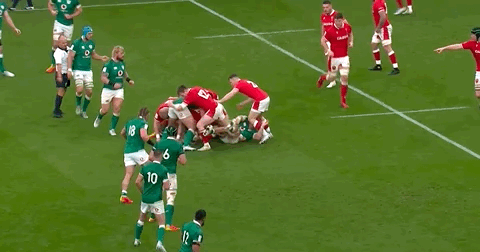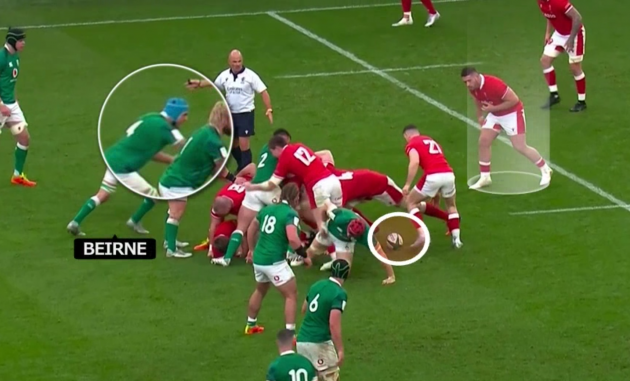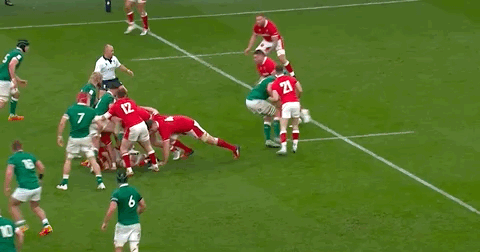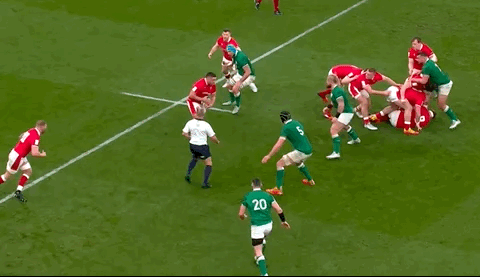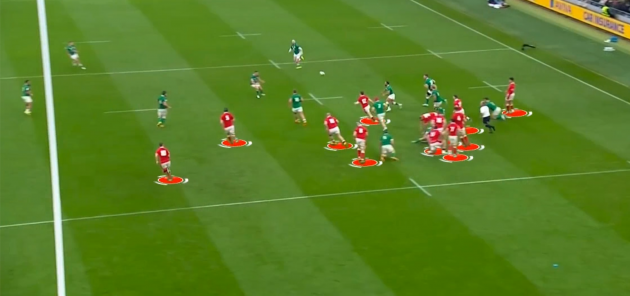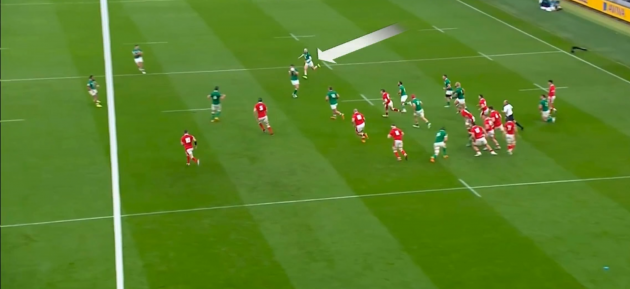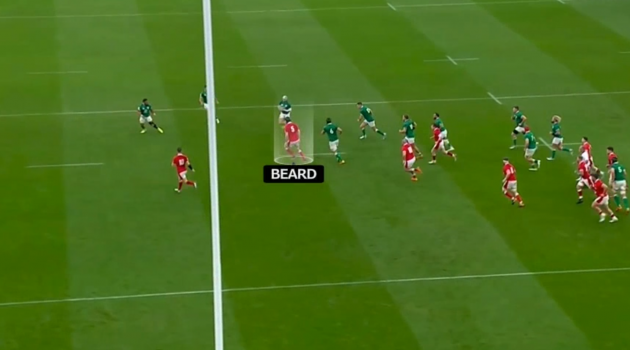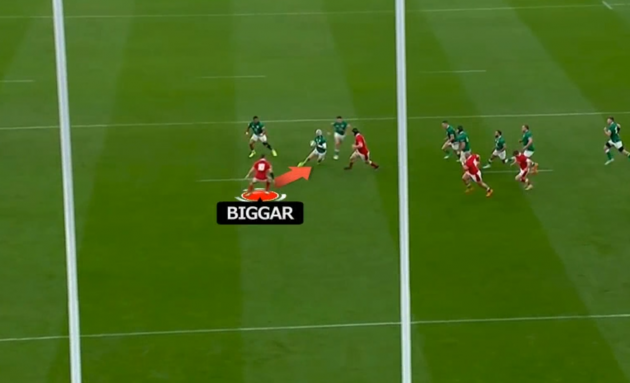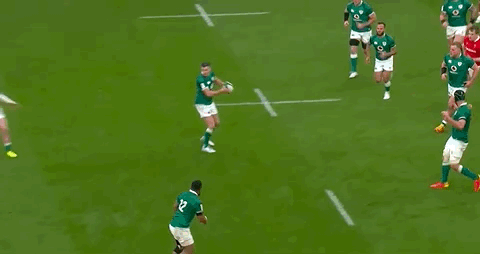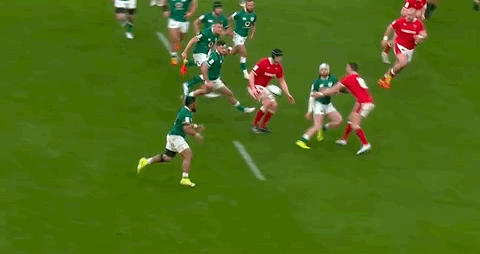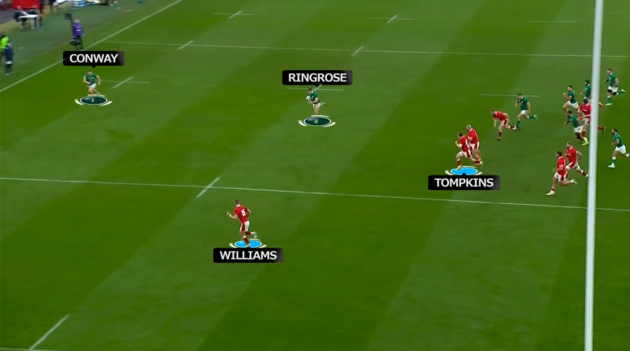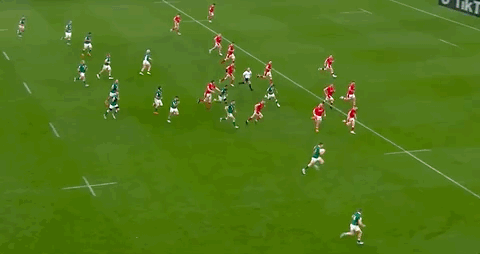JUST BEFORE THE Six Nations began, World Rugby issued a law clarification at the request of England Rugby.
In essence, England were keen to clear up whether or not the actions of Italy’s number 19 were legal in the instance below:
Argentina are setting up for a box kick here using a long ‘caterpillar ruck’ and Italy’s number 19, Marco Fuser, asks the referee if the ball is out of the ruck.
“Yeah, ball is out,” confirms the referee.
Fuser races forward and dives down onto the ball to regain possession, blasting Argentina’s scrum-half out of the way as he does so.
World Rugby clarified last week that this should have been a penalty to Argentina under Law 15.16 (d) which states that players must not “fall over the ball as it is coming out of a ruck.”
What England wanted to know for sure is when a player is legally entitled to dive onto the ball after it has left a ruck.
World Rugby clarified that players “can only dive onto such a ball if it is more than one metre away from the ruck it has emerged from.”
That means that the incident below should have been a penalty against Racing 92 for falling on the ball within one metre of the ruck it emerged from.
And so, everyone in the Six Nations was aware that if the ball was sitting there right at the back of a ruck but the referee had deemed it was out, they couldn’t just run in and flop down onto the ball. They would have to stay on their feet and pick it up.
This whole area of the game – teams setting up for box kicks – has been messy in recent years and Ireland head coach Andy Farrell last week welcomed the clarification from World Rugby.
“They realised that it was taking too long and the five seconds [that referees are supposed to give teams to 'use it' at the back of the ruck] almost became three seconds and there was no consistency in that,” said Farrell.
“Then all of a sudden you couldn’t use your hands [to move the ball in the ruck], but it’s crept back in that players are using their hands. We had a meeting as coaches and referees and got the clarification we wanted. I think it’s clear enough. One metre is clear enough to me.”
Farrell’s point about scrum-halves using their hands to roll the ball back through rucks was a particularly pertinent one given what followed last Saturday when Ireland scored a superb try off the back of a turnover involving Wales attempting to set up a box kick.
Let’s jump in and take a look.
As we see above, Wales make a carry from a right-hand-side lineout on their own 22-metre line, their intention being to set up a ruck for scrum-half Gareth Davies to box kick from.
Davies gets it wrong, however, and Ireland’s Tadhg Beirne is watching like a hawk.
Note below how Davies uses his left hand to roll the ball back along the ground as Will Rowlands [number 4] comes to join the ruck and lengthen it with his left leg, aiming to give Davies more distance from the Irish defence to get his kick away.
As Ireland head coach Farrell alluded to, scrum-halves are not allowed to use their hands in this manner. If they’re going to move the ball back through a ruck, it has to be with their feet. As soon as a scrum-half moves the ball back along the ground with their hands, as Davies does here, the ruck is over.
Beirne is hyper-alert to this.
We can hear him shouting something like, “Hands! It’s out, sir?” to referee Jaco Peyper as he advances up the side of the ruck, glancing at the referee as he does so.
Peyper responds, “Yes, play!”
Aware of the law clarification, Beirne shows discipline not to dive at the ball and instead stays on his feet to pressure Davies into suddenly changing his plan and passing to prop Gareth Thomas.
Wales hadn’t been set up to carry here at all, meaning Thomas is completely isolated and he is pounced on by Ireland’s Caelan Doris and Andrew Porter, who makes an explosive strip in the tackle to turn the ball over.
It’s a moment that underlines Porter’s power and turnover threat – whether at the breakdown or in the tackle like this.
Wales could justifiably argue that Thomas’s knee hit the ground first, meaning Porter should have released, but it’s split-second stuff and referee Peyper is happy with the strip.
Ireland instantly snap into counter-attack mode to score an excellent try.
Rónan Kelleher reacts well to gather the scraps and pop the ball up to Jamison Gibson-Park, who feeds Johnny Sexton infield.
Wales are already in major trouble at this point, given how condensed they had been in one area of the pitch as they planned to chase a box kick up their right-hand side. As we can see below, 12 of their players are on the right side of the posts. Josh Adams is also still in the sin bin, so they only have 14 on the field.
Ireland left wing Mack Hansen accentuates their troubles by bursting up from his initial position in the backfield, where he was covering the box kick, and popping up on Sexton’s outside shoulder.
Hansen does an excellent job once he gets on the ball.
He recognises that Wales lock Adam Beard is in front of him – a player Hansen backs himself to get outside.
Doing so means that Hansen then forces Dan Biggar to turn in to deal with his running threat.
And having drawn in Biggar, Hansen smoothly releases the ball to Bundee Aki on his outside, as Hugo Keenan switches back inside Hansen.
It’s fluid stuff from Hansen and now Aki’s threat means that Wales left wing Johnny McNicholl has to turn in on the Ireland number 12.
Aki has a little more time on the ball but also does an excellent job of ensuring McNicholl has committed in on him before releasing his pass wider to Garry Ringrose.
Ringrose has Andrew Conway on his outside as he gets up to top speed, with Wales centre Nick Tompkins struggling to cover across and fullback Liam Williams in a horrible position with so much space for the Irish duo.
With such a headstart over Tompkins, and with Williams having to worry about Conway outside, Ringrose makes an early decision just to back himself here.
Rather than keeping the ball in two hands, which would slow his sprinting pace, Ringrose tucks the ball early in his right arm and continues at top speed, taking him beyond Tompkins and then through Williams as the Wales fullback turns in late.
It’s a satisfying try for Ireland on transition from a defensive situation to an attacking one, with just 14 seconds and five passes in between Porter’s strip and Ringrose’s score.
It all started with Beirne’s awareness at the initial ruck as Wales set up to box kick.



